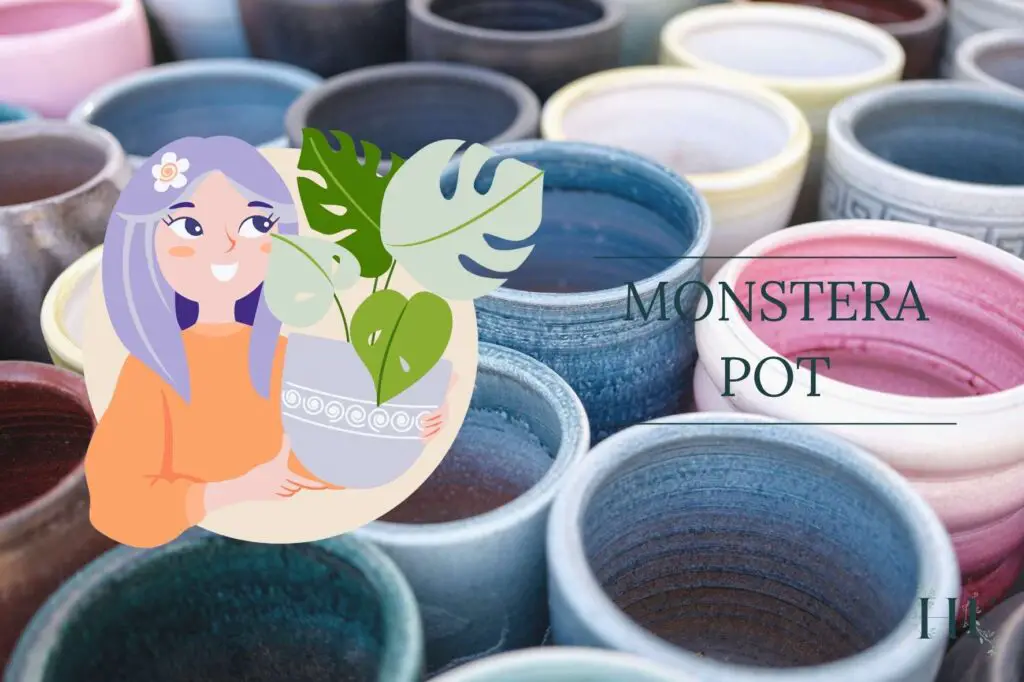Nowadays, there are so many different types of pots and planters that leads to wonder – how do you know which type of pot is best for your Monstera?
Monstera needs a pot with plenty of drainage holes that will allow the soil to drain freely. The material you choose for your Monstera’s pot will depend on factors such as your watering habits, and the temperature and climate where it lives in.
Also, the pot should be deep enough to support a stake or moss pole for your Monstera to climb up and 2 inches bigger in diameter than the previous pot, especially when repotting.
Keep reading to find out more about choosing the best pot for your Monstera.
How to Choose the Best Pot for Your Monstera
Aside from choosing the right soil, the next most important factor when repotting is getting the right pot for your Monstera and its environment.
It might not seem important, but actually, the planter you choose for a Monstera can directly affect your plant’s health.
Here’s how to choose the best pot for your Monstera:
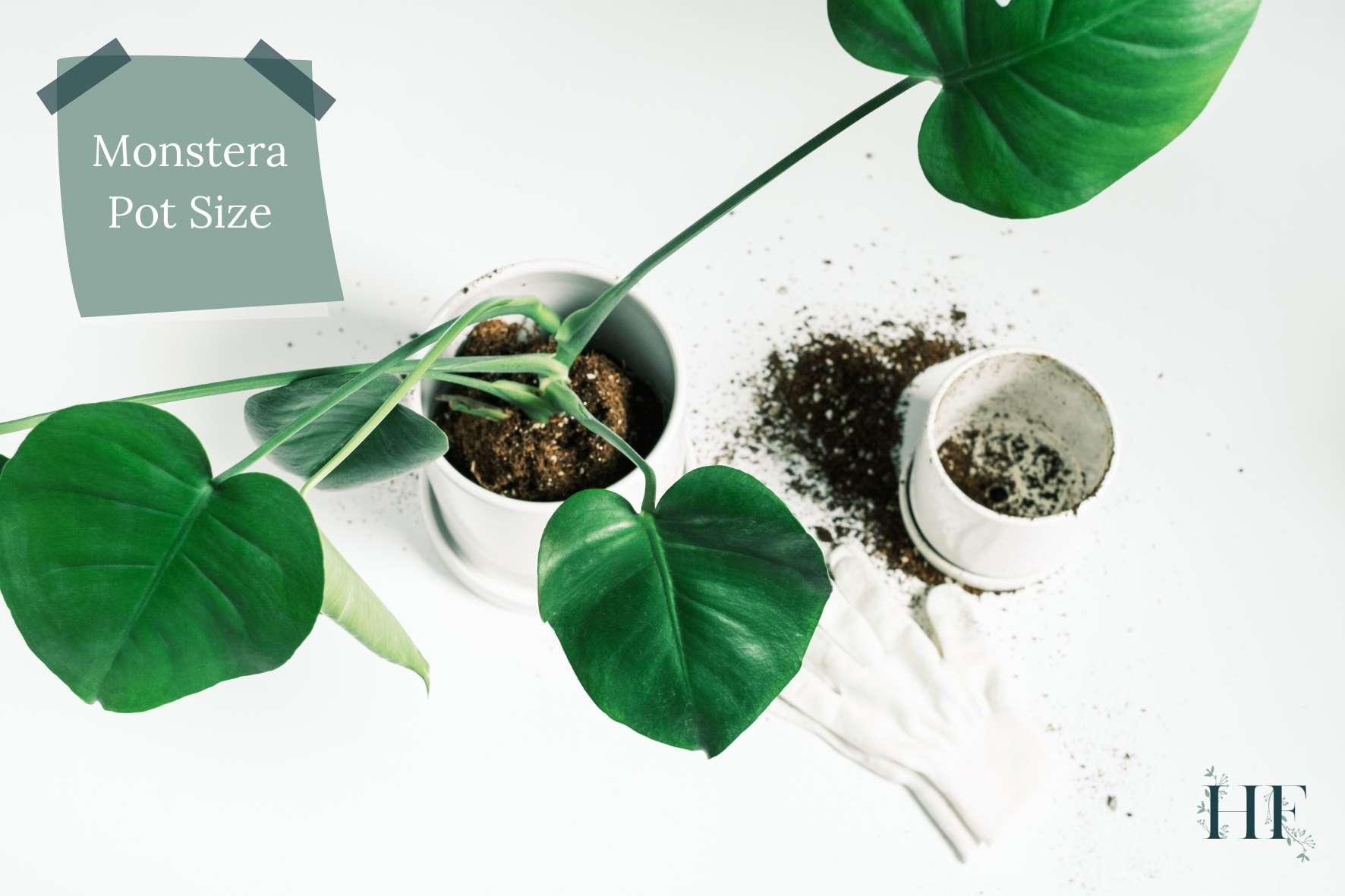
1) The Pot Size Is 2 Inches Wider and Deep Enough
What pot size to consider will depend on how big your Monstera is.
If your Monstera is still young, it will need a smaller pot, no more than 8 inches (20 cm) in diameter. A mature Monstera can get to a pot size of up to two feet (60 cm).
In terms of a pot’s depth, it should be deep enough to support a sturdy pole or trellis, so it doesn’t topple over.
Depending on how fast your Monstera grows, it will need to be repotted every 2 to 3 years.
When repotting, choose a pot that is 2 inches (5 cm) wider in diameter from the current pot size. This is enough for the roots to have room to grow and expand, but not too much that the soil will become waterlogged and lead to root rot.
Read also: A Guide to Repotting Monstera (When, Why and How) and Which Type of Soil Is Best for Monstera?
Problems with an Oversized Pot
A pot that is too big for your Monstera will hold onto too much water, i.e., the soil becomes waterlogged. As a result, roots will stay wet for too long, which can lead to root rot.
Monsteras like the soil to be moist, not wet. So it is important not to transplant them into a pot that is too big.
Problems with a Pot that Is Too Small
On the other hand, a pot that is too small can also cause problems as a small pot will restrict how much your Monstera plant grows due to root crowding.
Here are some signs that your Monstera is ready to be repotted:
- The roots are growing through the drainage holes.
- Its growth is stunted, i.e., your Monstera has stopped growing.
- Your Monstera is top-heavy or falls over.
If you spot these signs, it’s time to transplant your plant into a bigger pot.
However, in the case of a mature Monstera, it’s okay for it to be a little pot-bound.
Once your Monstera has reached a large size, and you don’t want it growing too much bigger, keeping it in the same size pot will prevent it from growing too rapidly.
To avoid it getting too pot-bound, you will need to prune the roots and top-dress your Monstera with fresh soil every year in the early spring.
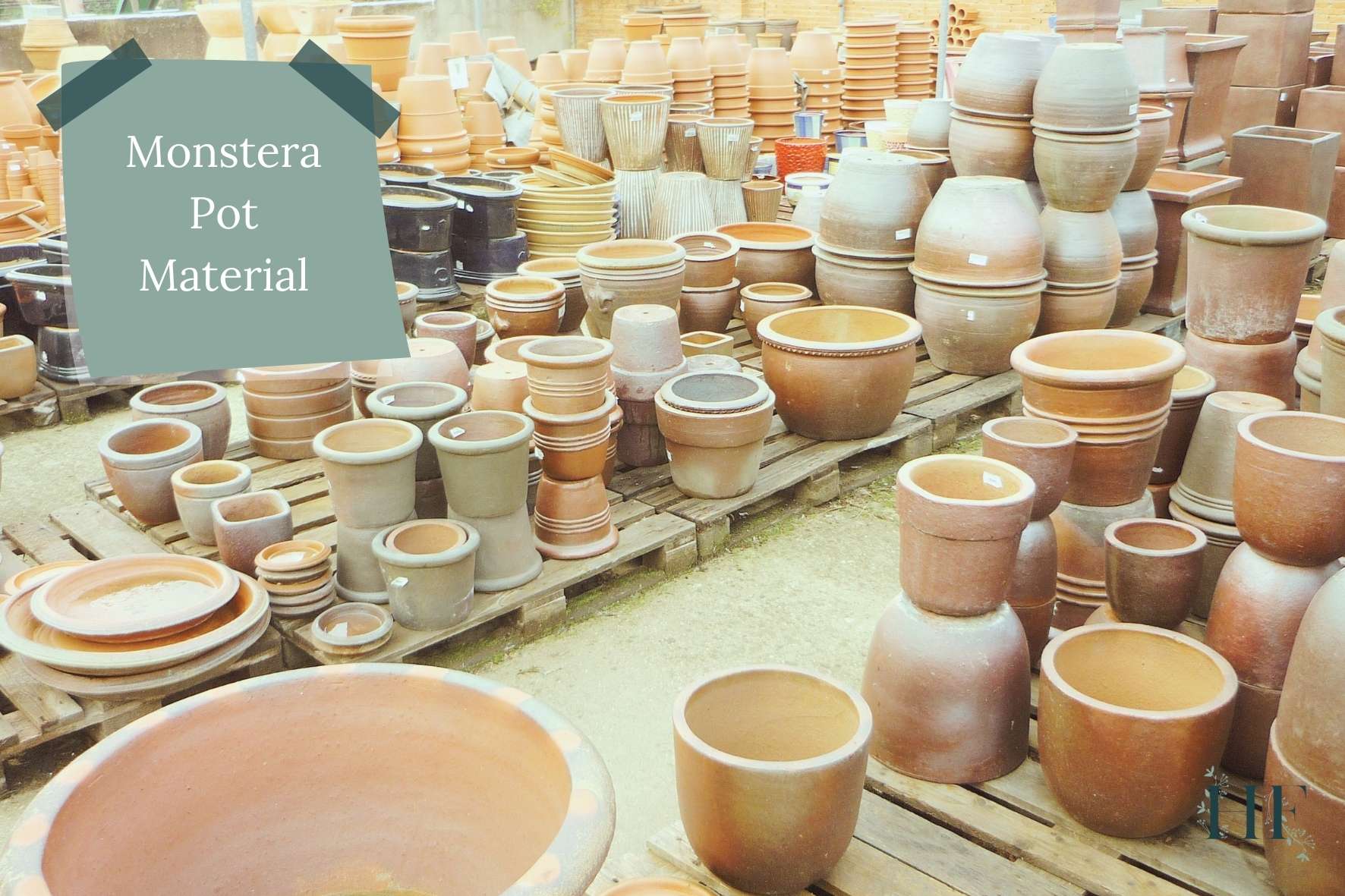
2) The Material Suits Your Monstera’s Living Conditions
What type of pot you choose will depend on your Monstera’s living conditions: the temperature, climate and watering habits.
There are many different materials used to make plant pots, but before going through those, let’s see how water, climate and temperature factors can determine which pot material you end up choosing.
A Pot Suitable for Your Watering Habits
Do you tend to overwater or underwater your plants?
- Pots for Overwaterers: Unglazed terracotta is a good pot material to consider because it is porous and will wick away extra moisture. Remember that Monsteras are very susceptible to root rot when their soil is too wet for too long.
- Pots for Underwaterers: Materials like plastic and glazed terracotta will keep moisture in the soil for longer than unglazed terracotta.
Regardless of your watering habits, you should always choose a pot with drainage. I will go deeper into this fact further down.
| WATERING HABIT | MONSTERA LIVING CONDITIONS | RECOMMENDED POT |
|---|---|---|
| Overwaterers | • Soil too wet for too long. • Risk of developing root rot. | Unglazed terracotta pot. |
| Underwaterers | • Not enough water as it evaporates. • Monstera leaves droop. | • Plastic pot. • Glazed terracotta pot. |
Read also: A Guide to Monstera Water Needs (How Often and When).
A Pot Suitable for The Temperature and Climate Your Monstera Lives In
Your area’s climate and temperature will affect your Monstera plant too. Here’s how to choose a pot based on those factors:
- Humid environment: Unglazed terracotta is a good option since it dries out a little bit faster.
- Dry environment: You want a material that holds in a little more moisture, such as plastic and glazed terracotta.
- Hot climate: Your Monstera is going to need water more often, so a pot that retains water will help keep it from getting thirsty. Plastic or glazed terracotta pots are more suitable in this case.
- Cold climate: Your Monstera plant is not going to need as much water, so there is a greater chance of overwatering. That’s why unglazed terracotta is more suitable.
| TEMPERATURE | MONSTERA NEEDS | RECOMMENDED POT |
|---|---|---|
| Hot | • Water evaporates faster. • Pot needs to retain water. | • Plastic pot. • Glazed terracotta pot. • Metal pot. |
| Cold | • Monstera doesn’t need as much water. • Water evaporates slowly. | Unglazed terracotta pot. |
Read also: Monstera Humidity & Temperature Needs – 7 Tips to Get It Right.
Once you know what material suits best your Monstera’s living conditions, you can look for a planter that is aesthetically pleasing too!
When using plastic pots, especially those that look like nursery or florist pots or are made of clear plastic, you could use the decorative pot as a cache pot, keeping the plastic one inside it.
Look at the Monstera Pot Ideas section for some inspiration!
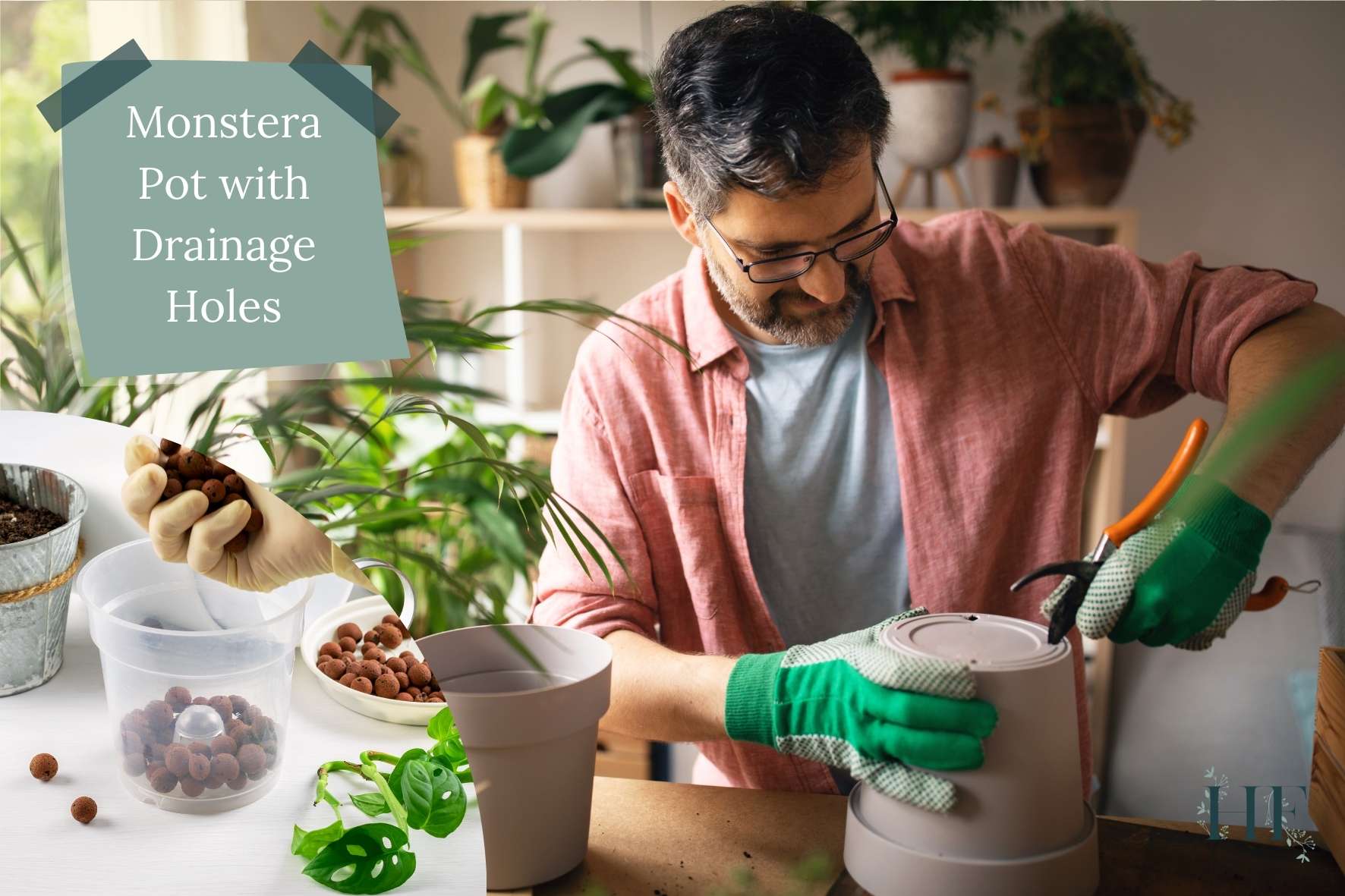
3) It Has Drainage Holes
Regardless of the size and material of your pot, it is vital for your Monstera’s pot to have drainage holes in the bottom for excess water to leave the pot.
Monsteras do not like their soil to stay wet for too long, as they are susceptible to root rot.
Planters with built-in drainage holes can come with a matching saucer that sits under the pot to catch the excess water.
However, sometimes the nicest pots have no drainage. Cache pots tend to be the prettiest and more ornate ones, especially among indoor pots.
If you are looking for a pot without drainage, also called a cache pot (or decorative pot), there are two options that can prevent holding extra water at the bottom of the pot, decreasing the likelihood of root rot:
- You could use an outer decorative planter along with a thin plastic nursery pot liner inside it.
- Alternatively, you could drill a hole in the bottom of the cache pot.
10 to 15 minutes after watering, remember to either empty the cache pot or the saucer of excess water so your Monstera doesn’t sit in it.
Personally, I have tried both options and following my plant’s living conditions, I prefer to use a plastic pot inside the decorative one.
This setup allows me to have the best of both worlds: the plastic pot is relatively light, and it’s easy to repot, but the ceramic cache pot provides stability to keep the plant from falling over.
Finally, I would avoid using a cache pot with no drainage since it can be detrimental to your Monstera’s health. Consider trying the two options I suggested when choosing a cache pot.
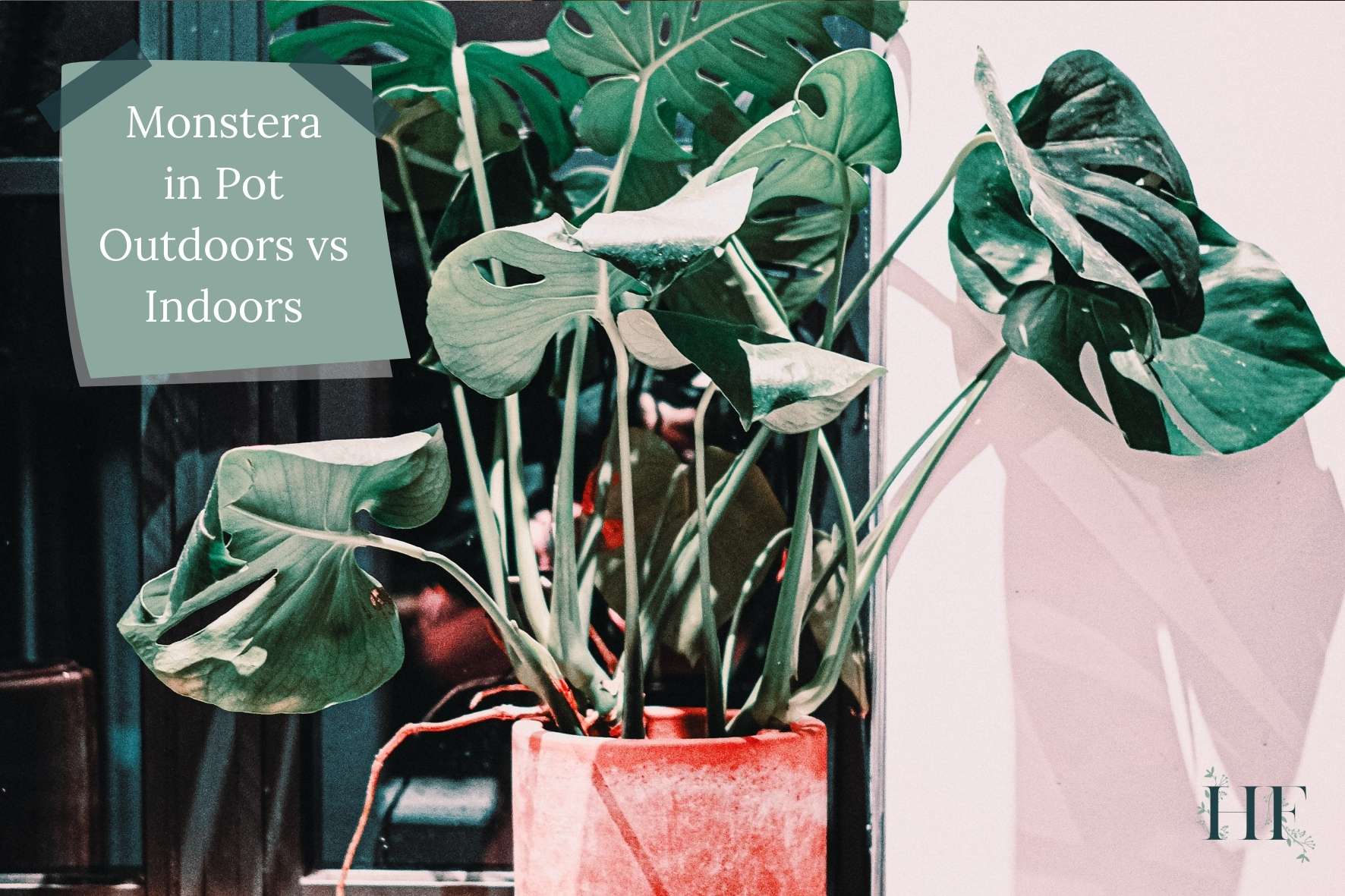
4) Different Pot If Growing Indoors or Outdoors
Growing your Monstera indoors or outdoors will also determine what kind of pot you will need.
- Indoors: You can control how much water your Monstera gets. Plus, your plant is protected from harsh direct sunlight and wind as well.
- Outdoors: Your Monstera is at the mercy of the climate in your area. This could be lots of sun, rain and wind.
When growing outside, no matter the weather, your Monstera will likely get more sunlight than it would be if growing inside. This fact will increase its growth rate and water intake.
If you live somewhere rainy, your Monstera’s pot definitely needs to have lots of extra drainage holes. In this case, it’s best not to use a cache pot since it will collect lots of water.
You probably will have to adjust your potting mix too – perlite, for instance, will help the soil drain better when it rains a lot.
If you live somewhere hot and sunny, you will want your Monstera in a pot that will hold onto water for a little longer, like plastic or glazed terracotta.
If it is windy, you want to make sure your pot is heavy enough that your Monstera will not topple over. Plastic pots will be too light for a mature Monstera. Instead, you may want to consider terracotta pots.
I have also found it useful to place a couple of heavy rocks at the bottom of the pot to keep it balanced. However, if it gets too windy, you can shelter your Monstera or bring it inside during very windy weather to avoid its leaves getting damaged.
Read also: How to Care for Monstera in Winter – Can I Put It Outside? – where I write about growing your Monstera in a pot outdoors.
Monstera Pot Ideas
Here are some Monstera planter ideas that you may want to consider:
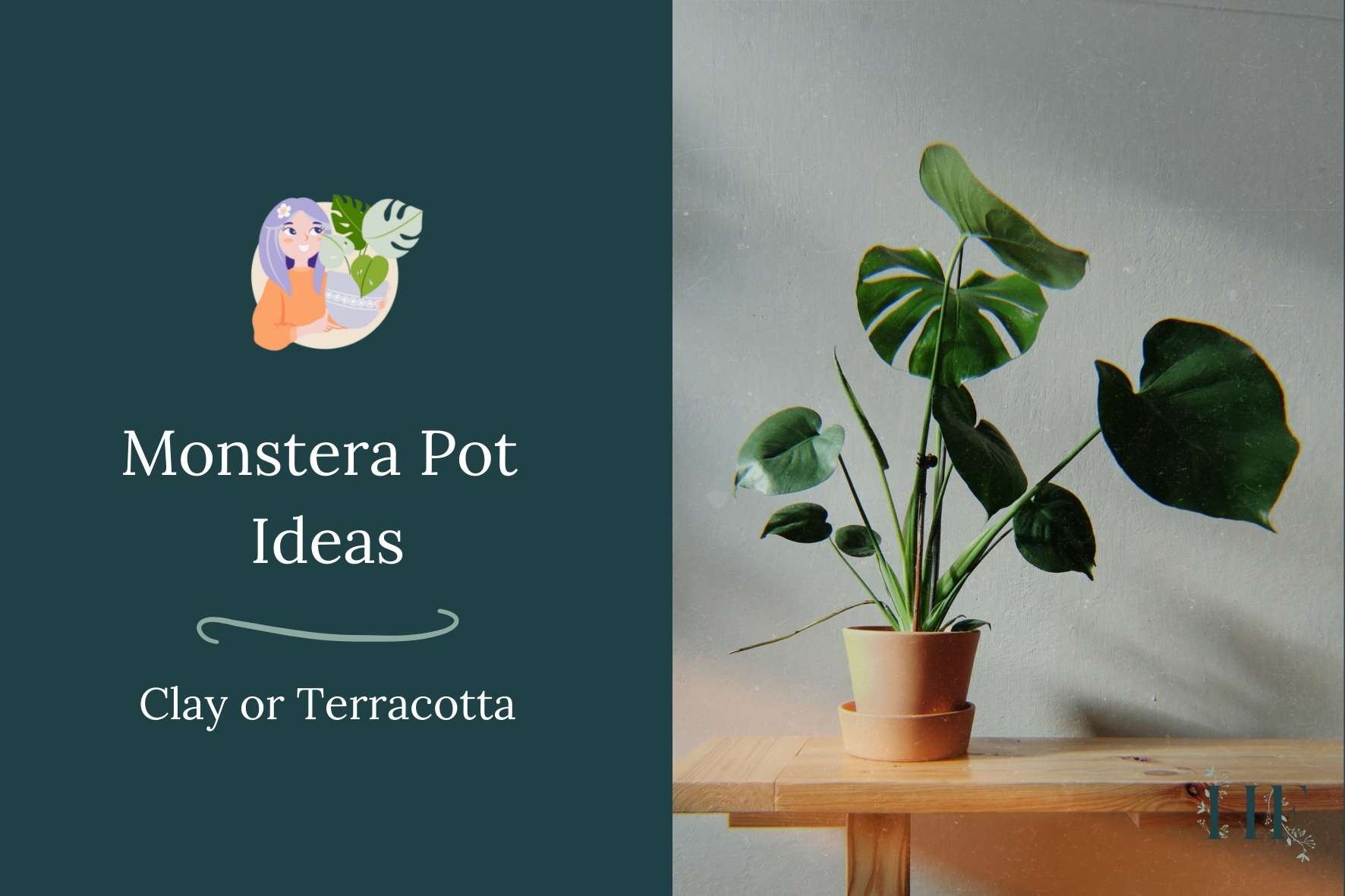
1) Clay or Terracotta Pot (Glazed and Unglazed)
Terracotta pots are a great choice for your Monstera. They are fire-kilned, unglazed clay pots made using a particular type of soil and often appear rusty red. You can use them both indoors and outdoors.
Should you go for glazed or unglazed?
- Glazed Terracotta Pots: They have been sealed with either clear or decorative glaze. These pots are non-porous and function similarly to a plastic or ceramic pot. They hold in moisture and keep the soil moist for a longer time – a problem if you tend to overwater your plants since you run the risk of soggy soil.
- If you tend to underwater your plants, choose glazed terracotta pots.
- Unglazed Terracotta Pots: They have not been sealed and are porous. Water from the soil can be absorbed by the pot and then released into the air. Porous pots can cause the soil to dry out quickly leaving your Monstera plant scrounging for moisture.
- If you tend to overwater your Monstera or if your Monstera is going to live outside in a rainy area, choose unglazed terracotta pots.
See this terracotta pot selection on Etsy.
| TERRACOTTA PROS | TERRACOTTA CONS |
|---|---|
| Unglazed: It will allow moisture and air to pass through its wall. The soil dries fast as moisture wicks out, reducing overwatering problems. | Unglazed: You will need to water your Monstera more frequently. |
| Glazed: It insulates your plant from quick temperature changes such as a hot day outdoors or frost. | Unglazed: No protection. Plus, frost may break it. Also, it’s not waterproof so it can stain the surface where it sits. |
| It’s heavy, meaning it will remain upright even when the wind blows. | Might get too heavy to move around when you need to. |
| It provides a sturdy container to hold the weight of a mature Monstera and its support structure (pole or trellis). | It will quickly break if it falls or something knocks it over. |
| Unglazed: You can tell the moisture level by looking at its surface. Where there is moisture, it has a different colouration. | It can turn white due to a process called efflorescence (a deposit of crusty white mineral salts appears on the surface). |
| Fully recyclable. | It may grow mould on the outer side. |
| It has a drainage hole and matching saucers. | It takes longer to disinfect. |
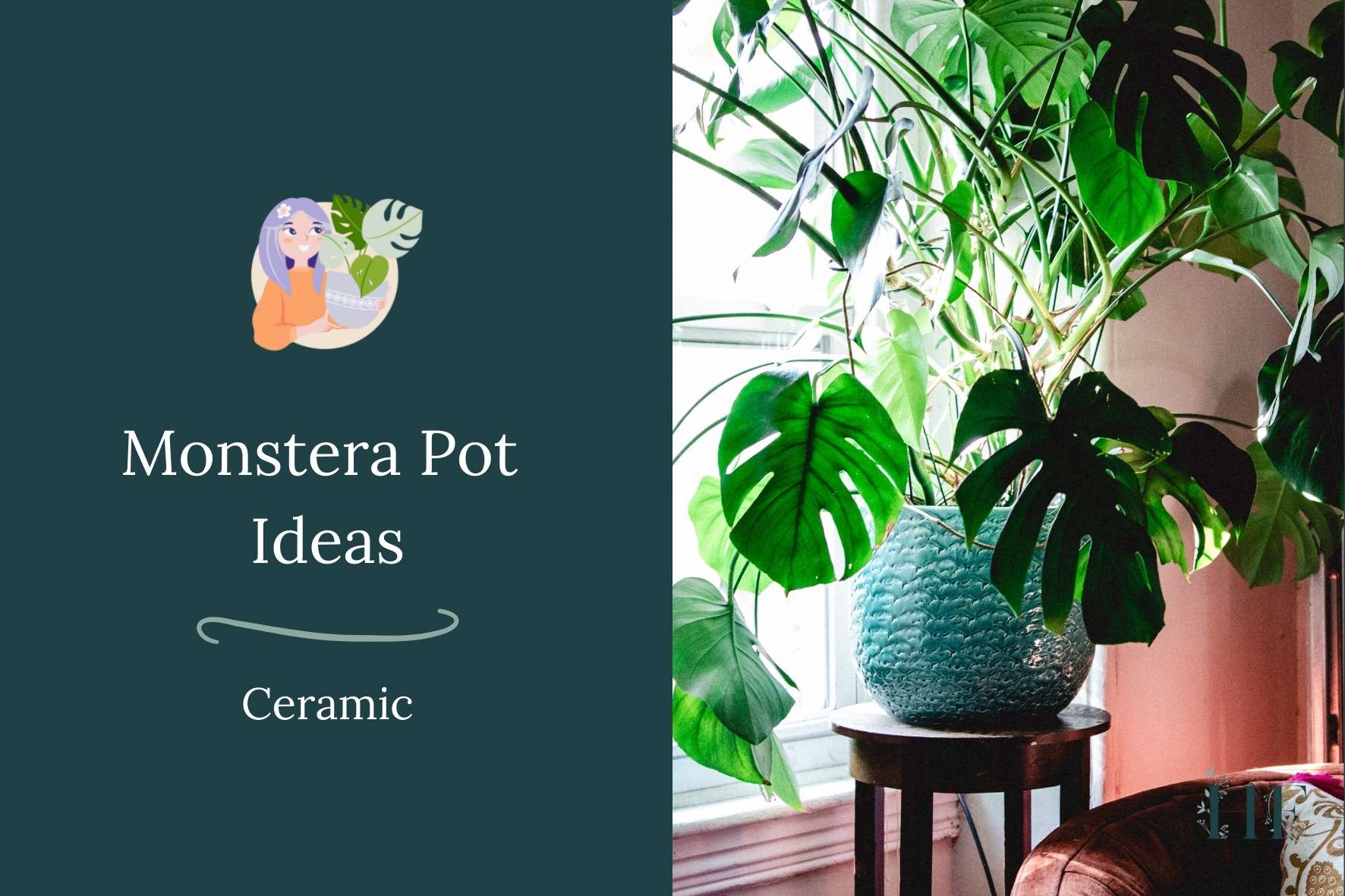
2) Ceramic Pots
Ceramic pots are clay pots lined with glaze, making them non-porous. So, they will retain moisture, just as plastic would. That’s why ceramic is an excellent choice for people fond of underwatering their Monstera.
Ceramic pots are the prettiest, and work as cache pots since most of them have no drainage holes. As mentioned before, you place a plastic nursery pot inside it or drill some drainage holes and add a saucer.
See this ceramic pot selection on Etsy.
| CERAMIC PROS | CERAMIC CONS |
|---|---|
| They are sturdy and heavy, your Monstera will not tip easily. | They can get too heavy to move if you have a big Monstera. |
| They insulate plants from sudden temperature changes. | They don’t allow air to pass through their walls due to their glaze coating. |
| They come in all shades, there’s an array of designs to choose from and they fit in with any kind of home decor. | No drainage holes. |
| They are fragile, they break easily. | |
| More expensive. |
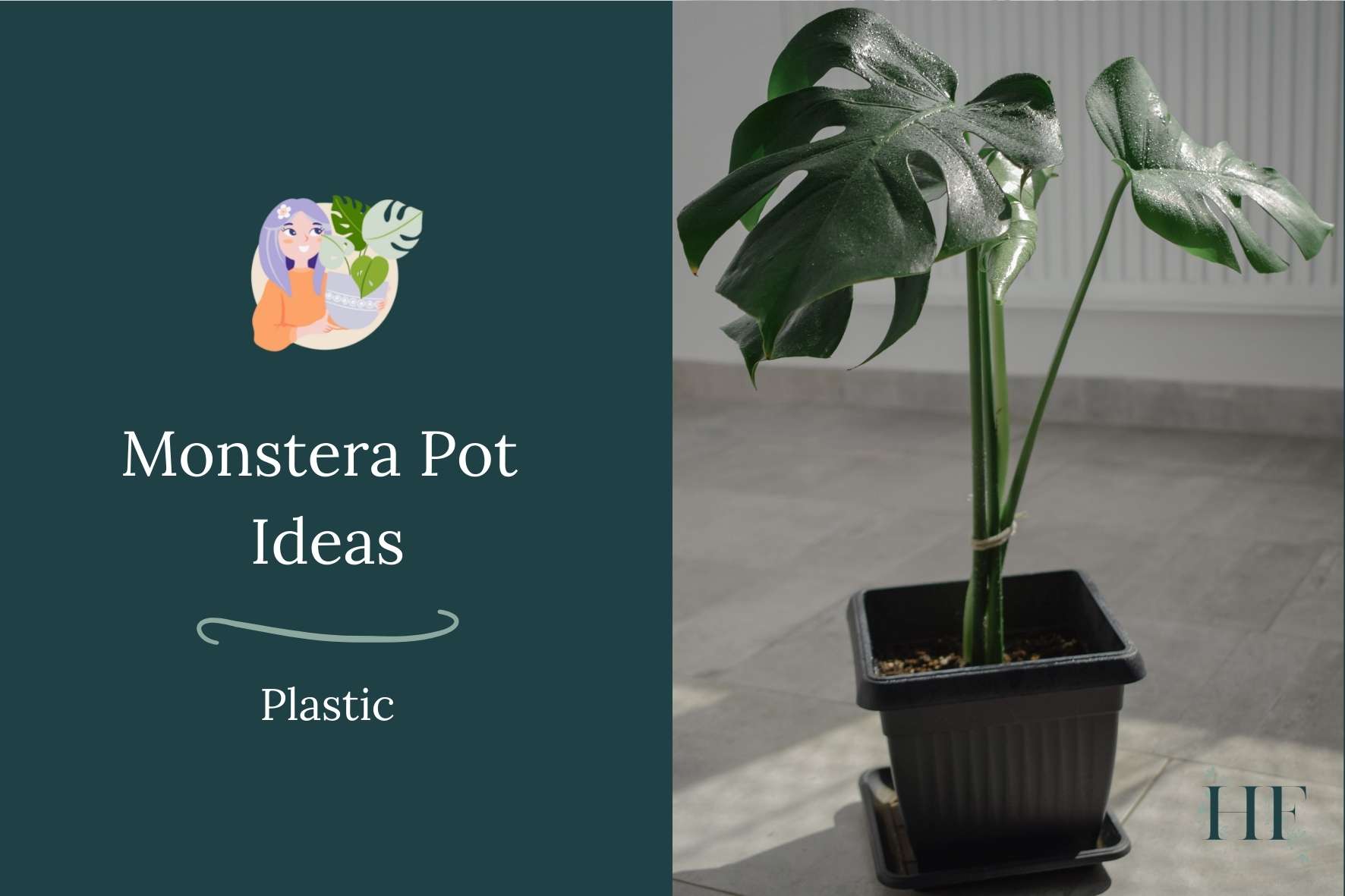
3) Plastic Pots
Plastic pots are among the most common and cheapest plant containers. Manufacturers use inert synthetic polymers that are safe for plants. However, you should still go for brands intended for houseplants as some may leach chemicals that will harm your plant.
Choose plastic material if you live somewhere drier, if you don’t water your Monstera too much, or if you are planning on moving it around often. They are perfect for people who tend to underwater their plants since they are not porous and will keep the moisture.
Thin plastic pots like nursery or florist pots (either translucent or transparent) are great to use inside a decorative ceramic pot. It’s a win-win situation since you get the best out of both options!
See this plastic pot selection on Etsy.
Also, for clear plastic pots with drainage holes, have a look here.
| PLASTIC PROS | PLASTIC CONS |
|---|---|
| They come in various colours, most translucent but some transparent, making them easier to complement your decor. | They are thin and offer very little insulation against heat or cold. Those that are black may heat up on hot summer days, and affect your plant’s roots. |
| Lightweight and very flexible. | Too thin and flimsy to be sturdy enough if you have a big Monstera. If you live in a windy area, your outdoor Monstera can topple over. |
| They resist breakages even when you drop them. | Low-quality brands undergo UV degradation that will make them fade and become brittle. |
| Probably the cheapest planter option. | Nursery and florist pots are quite thin and not attractive to display (better to use them inside a cache pot). |
| Transparent pots allow you to keep an eye on your Monstera’s roots and soil. You can see when your plant is rootbound and ready for a pot upgrade. | Transparent pots can be difficult to find in bigger sizes. |
| They have plenty of drainage holes. | |
| Some are recyclable. |
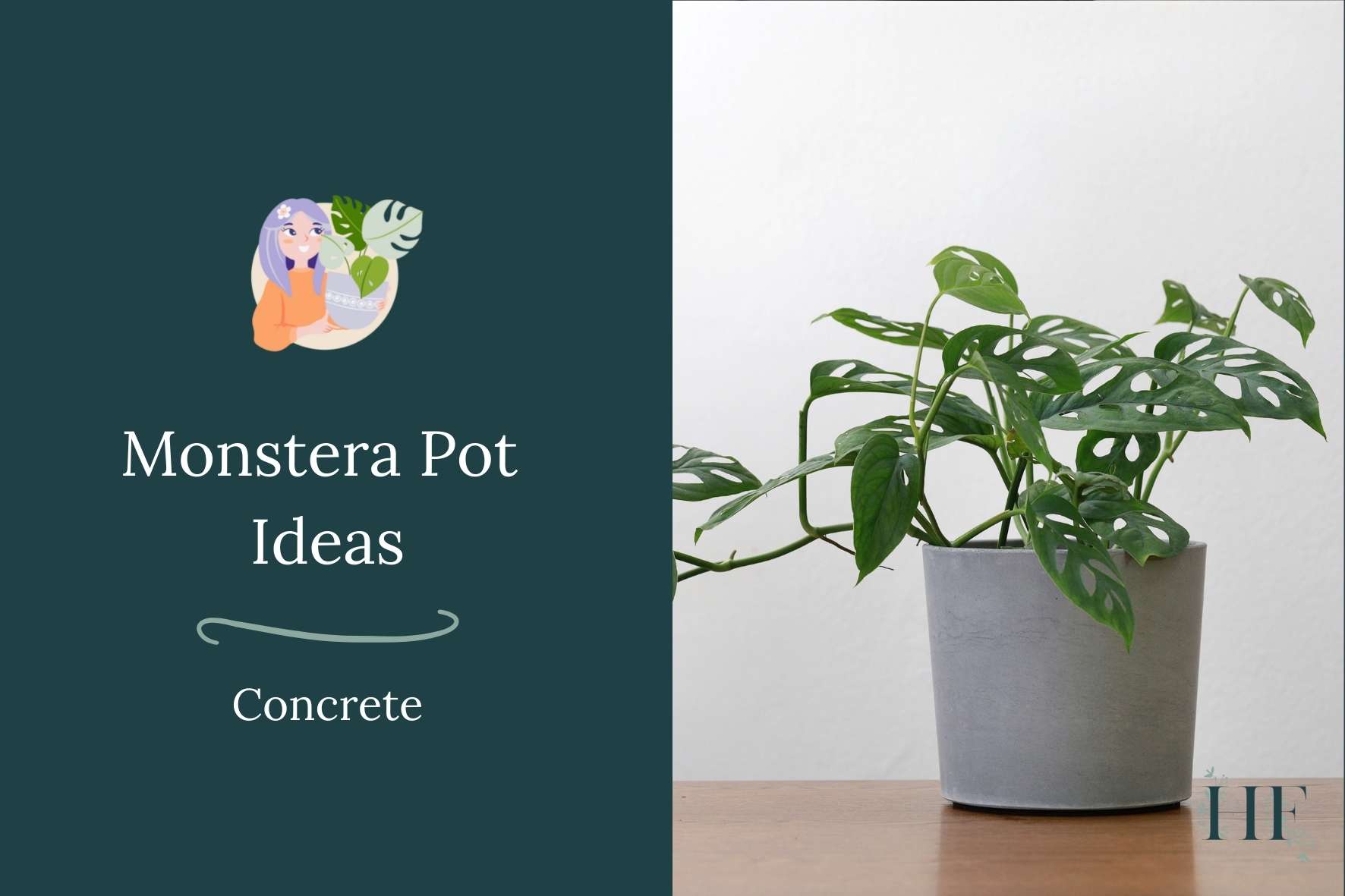
4) Concrete Pots
Concrete pots are the best choice for very big, mature Monsteras, as they are very heavy and will keep your plant from falling over.
They are porous, so they will allow some water and air to pass through their wall. Concrete planters are also a good choice for overwaterers and for Monsteras growing outside.
Like ceramic pots, they may or may not have drainage holes. Keep this in mind as you shop.
See this concrete pot selection on Etsy.
| CONCRETE PROS | CONCRETE CONS |
|---|---|
| Attractive containers that come in many colours and shapes. | They may get stains as mineral salts move from the soil to their outer surface. |
| Suitable for indoors and outdoors (like terracotta pots). | They can end up with moss growth. |
| Heavy, stable and sturdy, ideal for big, mature Monsteras since they won’t tip over. | Too heavy to move around (you can place a base with wheels if kept indoors). |
| Durable and sturdy material (not easily breakable and will last for decades). They withstand wind or rain. | The high content of lime in concrete may create a soil pH that may not favour your Monstera. |
| They offer insulation; your plant’s roots will be protected from cold or hot conditions. | |
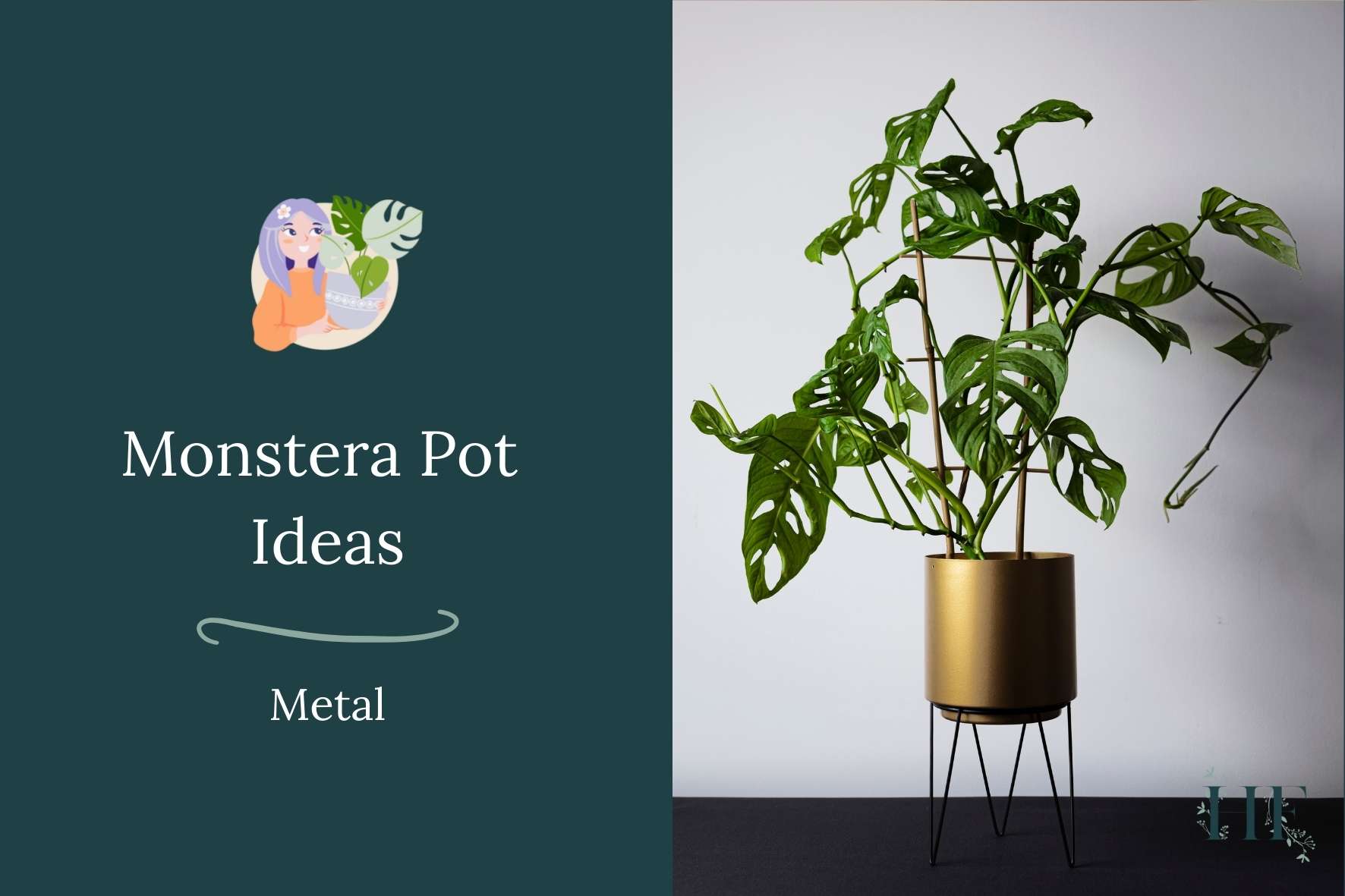
5) Metal Pots
Metal planters are made using mainly aluminium or steel. Also, they are given various finishes, including a galvanized finish (i.e., coated with a protective layer of zinc).
They are a great choice if you are looking for a cache pot that will add aesthetics.
These pots are non-porous and they have been made waterproof, either through the material or with some type of coating. So, choose a metal pot if you tend to underwater your Monstera.
See this metal pot selection on Etsy.
| METAL PROS | METAL CONS |
|---|---|
| They come in multiple shapes, sizes, colours, and designs. | The salts in some fertilisers may damage some metal finishes. |
| Durable material, it will not break easily. | It can get rusty. |
| No drainage holes (so it’s best to use it as a decorative pot). | |
| Metal pots that contain lead can cause health risks to your plant. Also, galvanized ones may leach zinc into the soil, which is harmful to your plant. Symptoms include stunted growth, leaves curling, leaf tip death, and chlorosis. | |
| They can get very hot or cold, especially if used outdoors. |
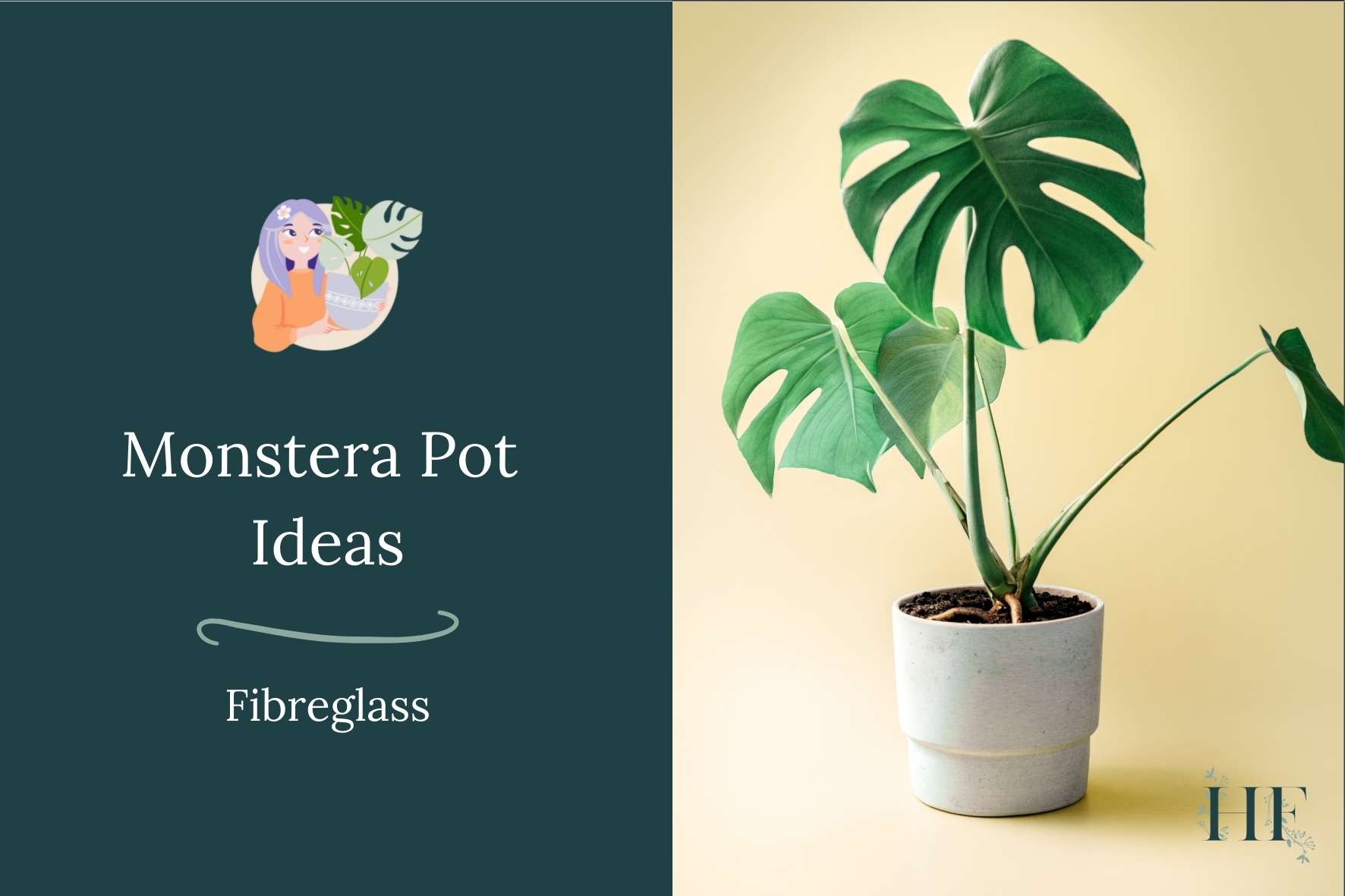
6) Fibreglass Pots
Fibreglass is another lightweight, synthetic planter. They are essentially similar to plastic pots but have a glass fibre reinforcement.
It’s also a non-porous material, so water and air will not travel through the walls. If you are prone to underwater your Monstera, choose a fibreglass pot. They are also suitable if you need durable planters that are not heavy.
See this fibreglass pot selection on Etsy.
| FIBREGLASS PROS | FIBREGLASS CONS |
|---|---|
| Available in many attractive designs and elegant colours. | They are expensive. |
| Lightweight. | Not ideal for mature Monsteras or those growing outdoors since they are unstable and your plant can fall over. |
| Durable; they don’t crack, rust or splinter easily. | They may wear over time, making them rugged if you use harsh chemicals, abrasive material, or stiff brushes. |
| Weather resistant; they can withstand all seasons. | |
| Suitable indoors and outdoors. Plus they are UV resistant. | |
| They have drainage. |
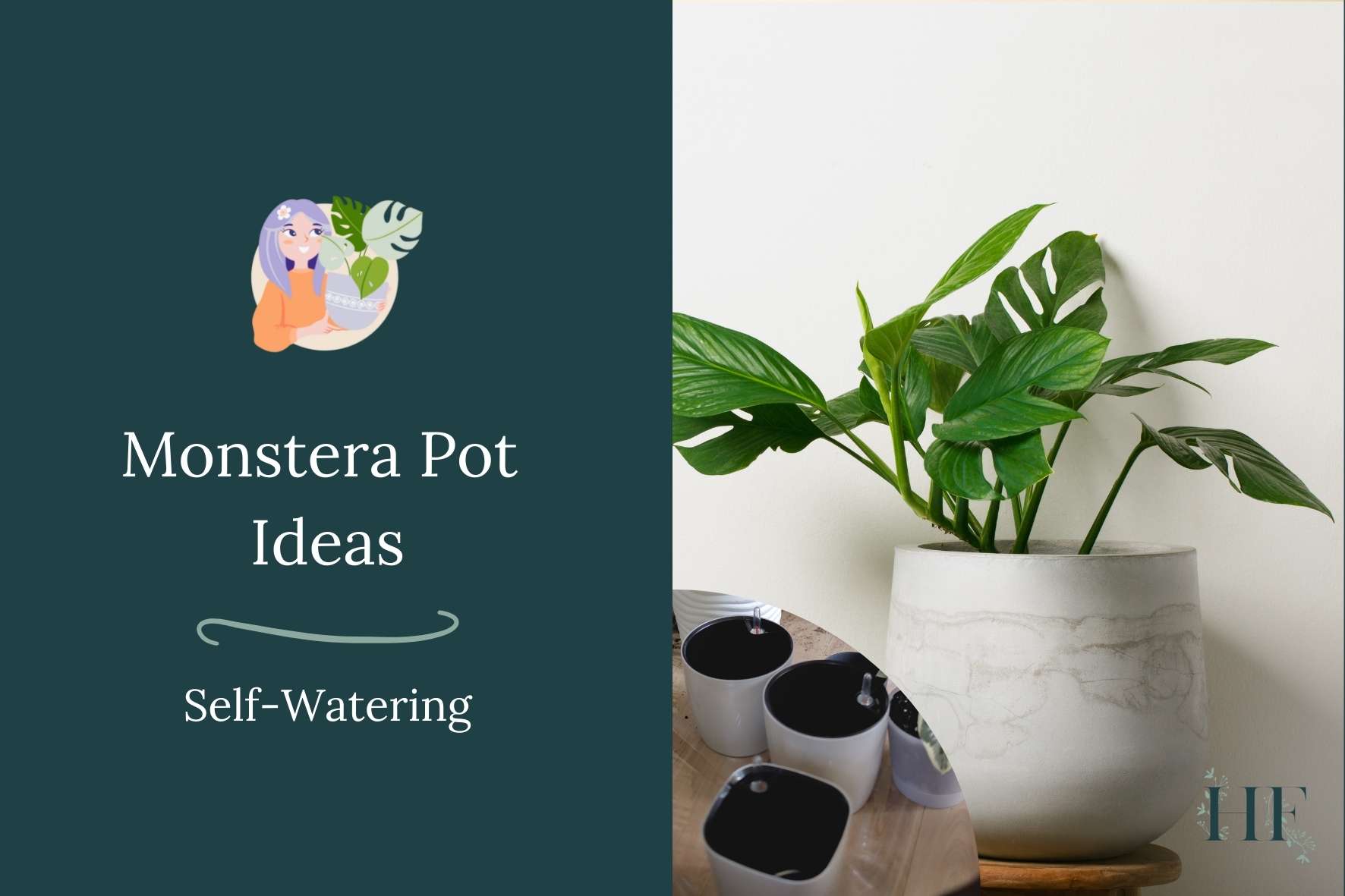
7) Self-Watering Pots
Self-watering pots are suitable for tropical plants like Monsteras.
These pots have a system that contains a reservoir that holds water with an inlet and outflow. You simply fill the reservoir, and thanks to its wicking mechanism, it will slowly wick the water into the soil.
Self-watering planters are an excellent choice for people who struggle with watering their plants or have a busy schedule.
See this self-watering pot available on Amazon – it comes in different sizes and colours.
| SELF-WATERING PROS | SELF-WATERING CONS |
|---|---|
| There is a variety of styles and designs. | They are expensive. |
| It helps retain nutrients in the soil. | It doesn’t do well in wet or humid environments. |
| Promotes healthy root growth. | You must check the self-watering pots to ensure your plants don’t become waterlogged or rotten. |
| They provide consistent moisture. They conserve water and distribute it in the right amount and at the right time. | Not suitable for all plants (especially succulents and cacti since they need dry soil between waterings and don’t tolerate excess water). Also, not suitable for thirsty plants. |
| It saves time. | It can become a breeding ground for mosquitoes. |
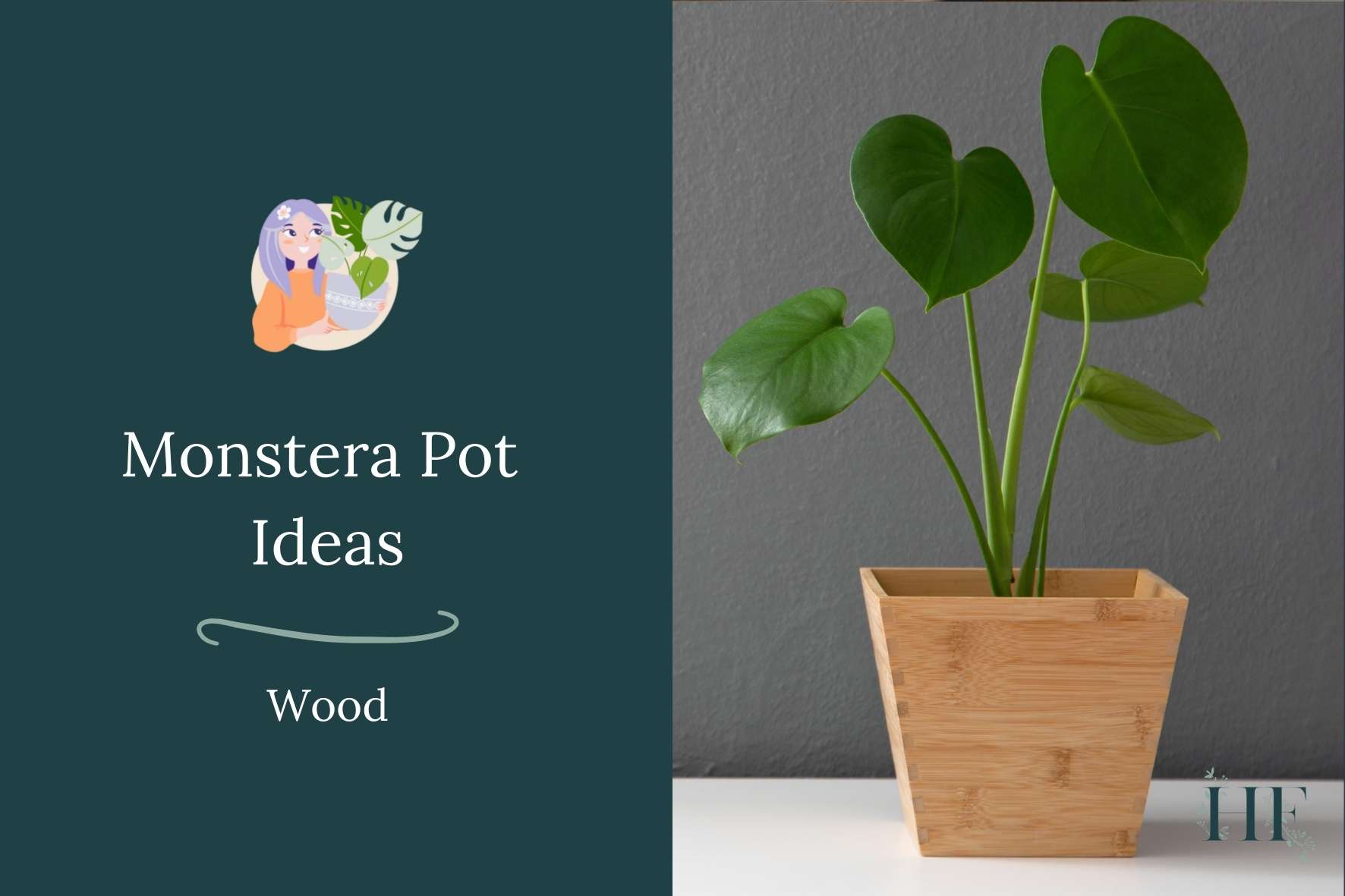
8) Wooden Pots
Wooden pots are an attractive option made from different types of wood but are high maintenance.
Like unglazed terracotta, unfinished wood is porous and will wick away extra moisture from your Monstera’s soil. Treated wood is non-porous though.
See this wooden pot selection on Etsy.
| WOOD PROS | WOOD CONS |
|---|---|
| They come in a wide variety of styles and sizes. | Wood can rot easily, even when treated (although timbers like redwood and cedar are rot-resistant). To avoid rot, you can use a wooden pot as a cache pot instead. |
| Medium weight; they are lighter than clay, ceramic, or concrete. So they are easier to move around when necessary. | Not a durable material. They are prone to pests, rotting, rust, and splitting. The wood can split, and the metal bands (in the case of a half-barrel) or nails can go rusty and weaken the structure. |
| They stand up to the cold well. | They are high-maintenance. They require frequent care like rustproofing metal bands or nails every year, checking for weather and water damage, and touching up areas with any paint chips. |
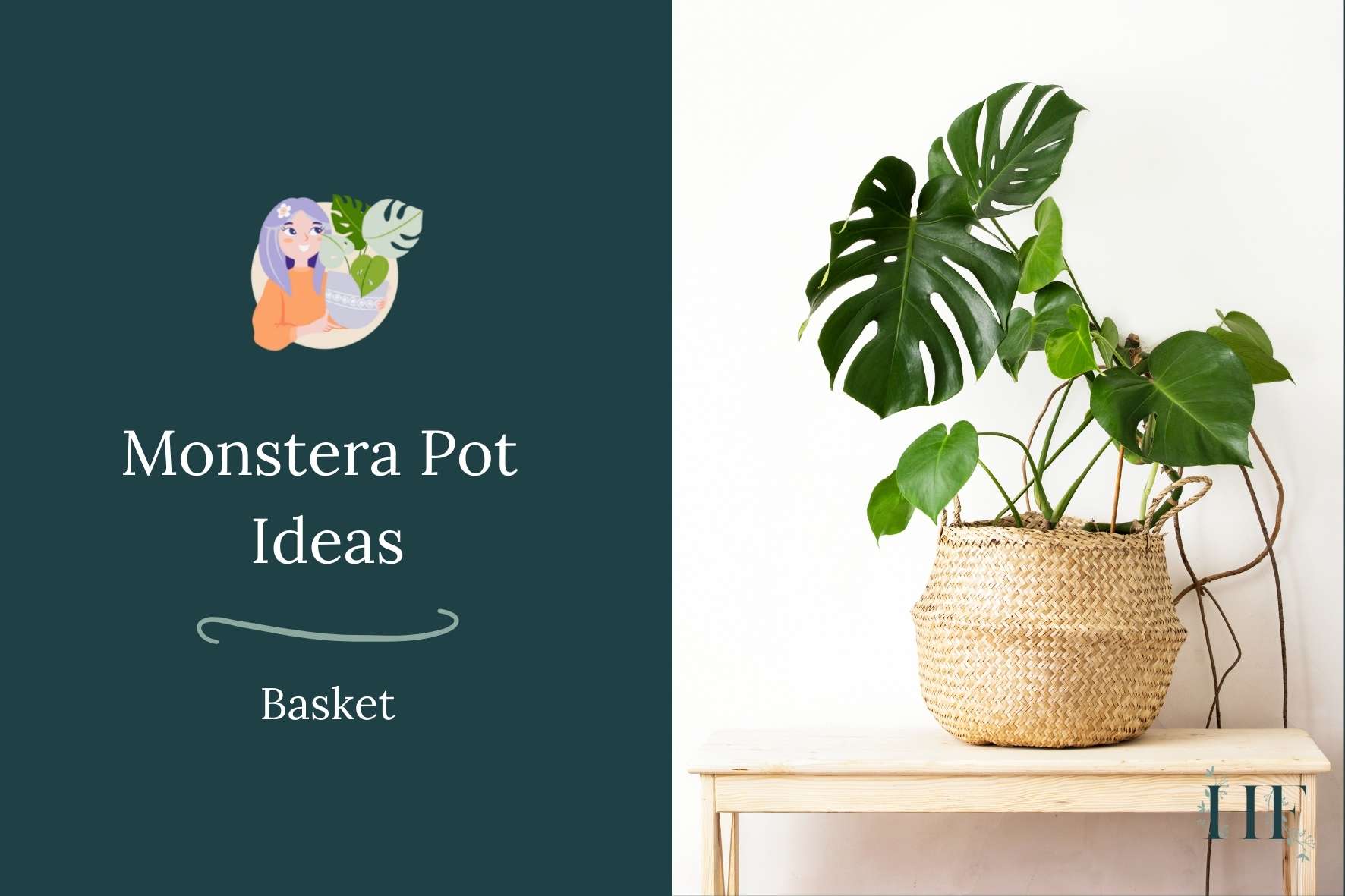
9) Basket Pots
Baskets are made in a wide range of materials, including:
- Wicker.
- Straw.
- Plastic.
- Metal.
- Bamboo.
- Palm.
- Carbon fibre.
- Etc.
Baskets used as cache pots are a great choice for large Monsteras since you can even place the nursery pot inside and save yourself the cost of purchasing a giant pot while still matching your interior style.
See this basket pot selection on Etsy.
| BASKET PROS | BASKET CONS |
|---|---|
| Aesthetically pleasing and come in different materials, weaving techniques, shapes and colours. | They rot quickly after coming in contact with moisture. To prevent this, line the inside of the basket with plastic and use a saucer at the bottom too. |
| Lightweight. | Not suitable for outdoors. |
| They are great to hide an ugly but functional plastic pot. | No drainage holes. |
| Sturdy and thick baskets last longer. |
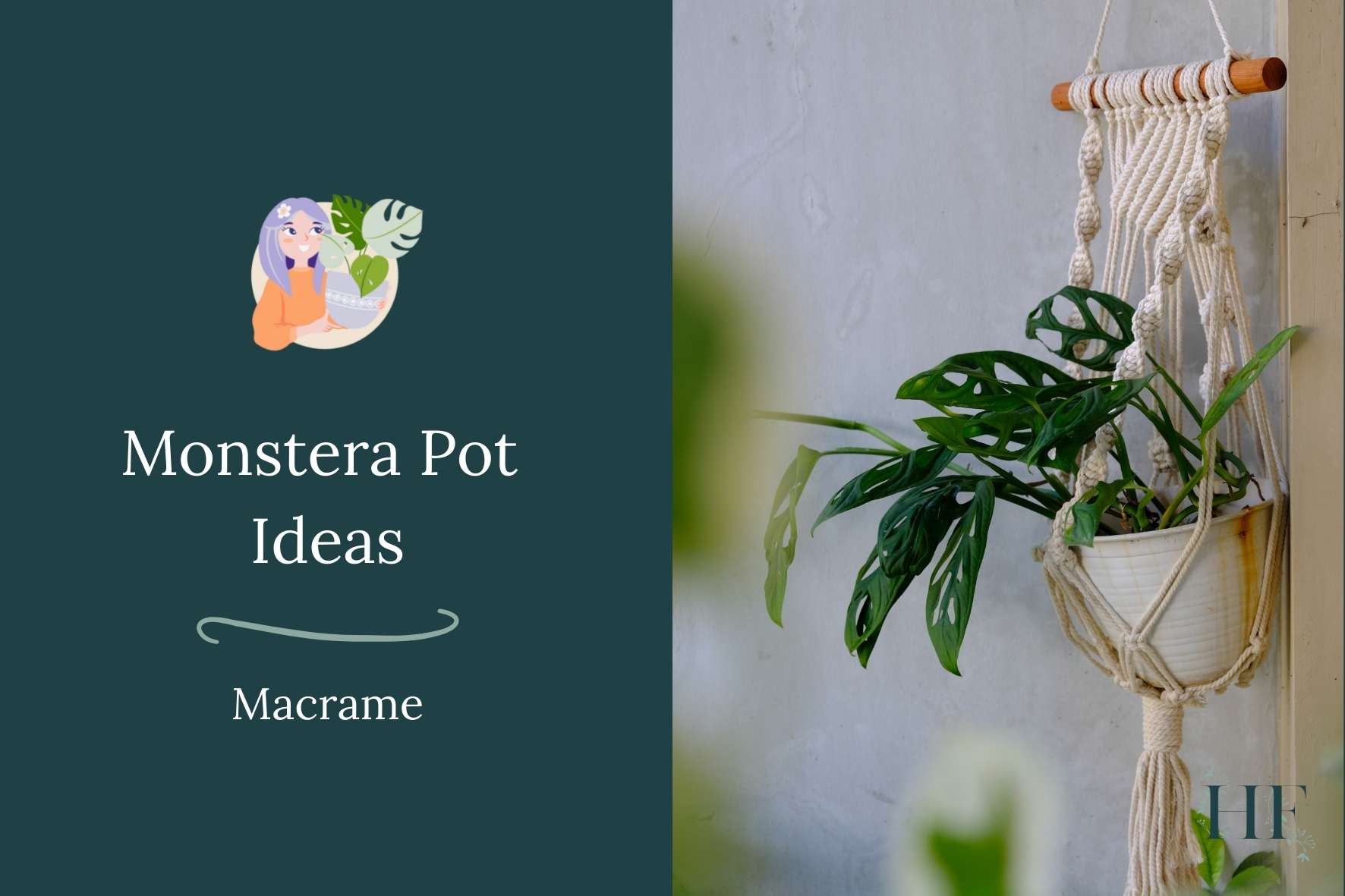
10) Macrame Pot Holder
Finally, if you fancy displaying your Monstera by hanging it and letting it trail…
You can choose a macrame pot hanger or a plastic hanging basket for smaller and younger Monsteras that trail like Monstera Adansonii (like in the image above).
Also suitable for Monstera Karstenianum, Monstera Standleyana, Monstera Obliqua, Monstera Pinnatipartita, and Monstera Siltepecana. You can check those varieties, here.
See this macrame pot holder selection on Etsy.
| MACRAME PROS | MACRAME CONS |
|---|---|
| A wide range of macrame styles. | Not suitable for heavy and mature Monsteras. More appropriate for a young Monstera Adansonii. |
| An attractive way to display plants by hanging them. | An expensive display, since you will also need a decorative pot and then a plastic pot with drainage holes inside it (otherwise water will be leaking from your plant). |
| Alternatively, you can choose a plastic hanging pot to get a similar effect. | More inconvenient to water your plant. |
Let me know if there are any other planter ideas that you would like me to cover 🙂

